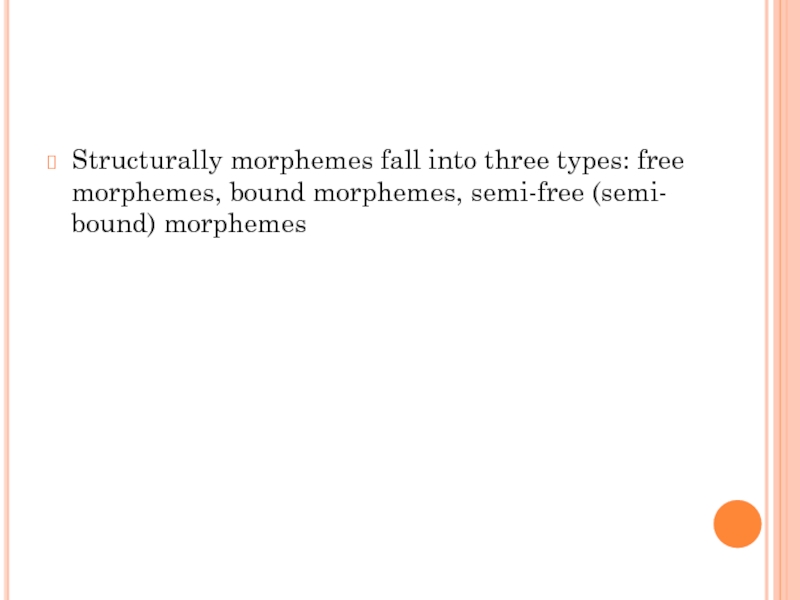Due
to the morphemic structure of the word all English words fall into
two large classes. They are so-called segmentable
words,
i.e. those ones allowing of segmentation into morphemes, e.g.
agreement,
information, fearless, quickly, door-handle, etc.,
and non-segmentable
words,
i.e. those ones not allowing of such segmentation, e.g. house,
girl, woman, husband, etc.
The
degree of morphemic segmentability is not the same for different
words.
Three
types of morphemic segmentability of words are distinguished:
complete,
conditional and
defective.
Complete
segmentability
is characteristic of a great many words the morphemic structure of
which is transparent enough, as their individual morphemes clearly
stand out within the word lending themselves easily to isolation.
There are, however, numerous words in the English vocabulary the
morphemic structure of which is not so transparent and easy to
establish.
Conditional
morphemic segmentability
characterises words whose segmentation into the constituent
morphemes is doubtful for semantic reasons. In words like retain,
contain, detain or
receive,
deceive, conceive, perceive the
sound-clusters [ri-], [di-], [кэn-]
seem,
on the one hand, to be singled out quite easily due to their
recurrence in a number of words, on the other hand, they undoubtedly
have nothing in common with the phonetically identical morphemes
re-,
de- as
found in words like rewrite,
re-organise, de-organise, decode.
Defective
morphemic segmentability
is the property of words whose component morphemes seldom or never
recur in other words. One of the component morphemes is a unique
morpheme. A unique morpheme is isolated and understood as meaningful
because the constituent morphemes display a more or less clear
denotational meaning. There is no doubt that in the nouns streamlet,
ringlet, leaflet, etc.
the morpheme -let
has
the denotational meaning of diminutiveness and is combined with the
morphemes stream-,
ring-, leaf-, etc.
each having a clear denotational meaning. The oppositions that the
different types of morphemic segmentability are involved in hardly
require any comments with the exception of complete and conditional
segmentability versus defective segmentability.
2.Analyze the Lexical layers of the English Vocabulary.
With
regard to the sphere of usage all the words fall into two groups:
1.
Neutral words, which can be used in any sphere of communication,
e.g., to go, to make, to do, thing;
2.
Words with a limited sphere of communication, which can be used in
learned or poetic texts, or in formal conversation. They are called
stylistically coloured words. Stylistically coloured words are
subdivided into two groups: formal (official) and informal
(colloquial).
Formal
vocabulary consists of terms, learned official vocabulary, poetic
and archaic words. Informal vocabulary is made up of familiar
colloquial words, slang, dialectisms, and vulgarisms. The boundaries
between these layers are not clear cut. Words can travel from one
layer into another, e.g., many terms have become part of neutral
vocabulary, such as radio, television, football. And otherwise, many
slang words became part of neutral vocabulary, e.g., donkey, to
tackle, teenager.
Besides
between neutral and stylistically coloured layer there may be words
and expressions equally important for these layers, they occupy an
intermediate position between them, e.g., fastidious, to fascinate.
They are characterized as common literary and can be used either in
colloquial conversation or in literary conversational style. Between
neutral and informal vocabulary there is also a group of common
colloquial vocabulary which stands between them. The criterion of
the reference of the word to this or that layer is not absolutely
reliable, but it is the only criterion existing now. A word may
belong to the neutral layer if it sounds neutral in any kind of
communication. In all other cases, it produces an unintentional
comical effect, especially when placed in another layer or when it
jars upon the ear in a different style. In this case it belongs to a
stylistically coloured layer.
Соседние файлы в предмете [НЕСОРТИРОВАННОЕ]
- #
- #
- #
- #
- #
- #
- #
- #
- #
- #
- #
Sign up
Log in
EnglishEspañol한국어日本語DeutschPortuguêsFrançaisMagyarItaliano
Log in
You need access
Sign up or log in to continue
Sign up
New to Prezi? Sign up
Prezi.com users should use ‘Log in with Google’
Forgot your password?Problems logging in?
Log in with Facebook
Log in with Google
Sign in with Apple
Log in with Microsoft
Sign in with Slack
If you click «Log in with Facebook» or «Log in with Google» and are not a Prezi user, you will be registered, and you agree to Prezi’s Terms & Conditions and Privacy Policy.
Single sign-on (SSO)
You need access
Sign up or log in to continue
Sign up
English
Español
한국어
日本語
Deutsch
Português
Français
Magyar
Italiano
© 2023 Prezi Inc.
Terms
Languages
- English
- Español
- 한국어
- 日本語
- Deutsch
- Português
- Français
- Magyar
- Italiano
© 2023 Prezi Inc.
Terms
PRINCIPLES OF MORPHEMIC ANALYSIS. TYPES OF WORD SEGMENTABILITY. CLASSIFICATION OF MORPHEMES. PROCEDURE OF MORPHEMIC ANALYSIS
The morphemic analysis aims at splitting a segmentable word into its constituent morphemes
The operation of breaking a segmentable word into the constituent morphemes is referred to in present-day linguistic literature as the analysis of word-structure on the morphemic level
Three types of morphemic segmentability of words are distinguished: complete, conditional and defective
Complete segmentability is characteristic of a great many words the morphemic structure of which is transparent enough, as their individual morphemes clearly stand out within the word lending themselves easily to isolation
Conditional morphemic segmentability characterises words whose segmentation into the constituent morphemes is doubtful for semantic reasons
Defective morphemic segmentability is the property of words whose component morphemes seldom or never recur in other words
Semantically morphemes fall into two classes: root-morphemes(the root-morpheme is the lexical nucleus of a ward, it has an individual lexical meaning shared by no other morpheme of the language) and non-root or affixational morphemes
Structurally morphemes fall into three types: free morphemes, bound morphemes, semi-free (semibound) morphemes
Разделы презентаций
- Разное
- Английский язык
- Астрономия
- Алгебра
- Биология
- География
- Геометрия
- Детские презентации
- Информатика
- История
- Литература
- Математика
- Медицина
- Менеджмент
- Музыка
- МХК
- Немецкий язык
- ОБЖ
- Обществознание
- Окружающий мир
- Педагогика
- Русский язык
- Технология
- Физика
- Философия
- Химия
- Шаблоны, картинки для презентаций
- Экология
- Экономика
- Юриспруденция
Содержание
-
1.
Principles of Morphemic Analysis. Types of Word Segmentability. Classification -
2.
The morphemic analysis aims at splitting a segmentable word into its constituent morphemes -
3.
The operation of breaking a segmentable word -
4.
Three types of morphemic segmentability of words are distinguished: complete, conditional and defective -
5.
Complete segmentability is characteristic of a great -
6.
Conditional morphemic segmentability characterises words whose segmentation into the constituent morphemes is doubtful for semantic reasons -
7.
Defective morphemic segmentability is the property of -
8.
Semantically morphemes fall into two classes: root-morphemes(the -
9.
Structurally morphemes fall into three types: free morphemes, bound morphemes, semi-free (semi- bound) morphemes -
10.
Скачать презентанцию
The morphemic analysis aims at splitting a segmentable word into its constituent morphemes
Слайды и текст этой презентации
Слайд 1Principles of Morphemic Analysis. Types of Word Segmentability. Classification of
Morphemes. Procedure of Morphemic Analysis
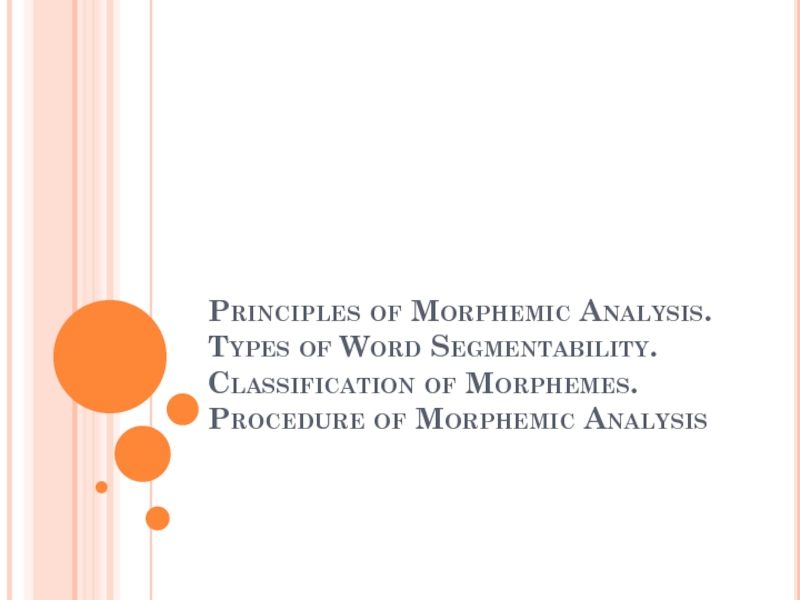
Слайд 2The morphemic analysis aims at splitting a segmentable word into
its constituent morphemes
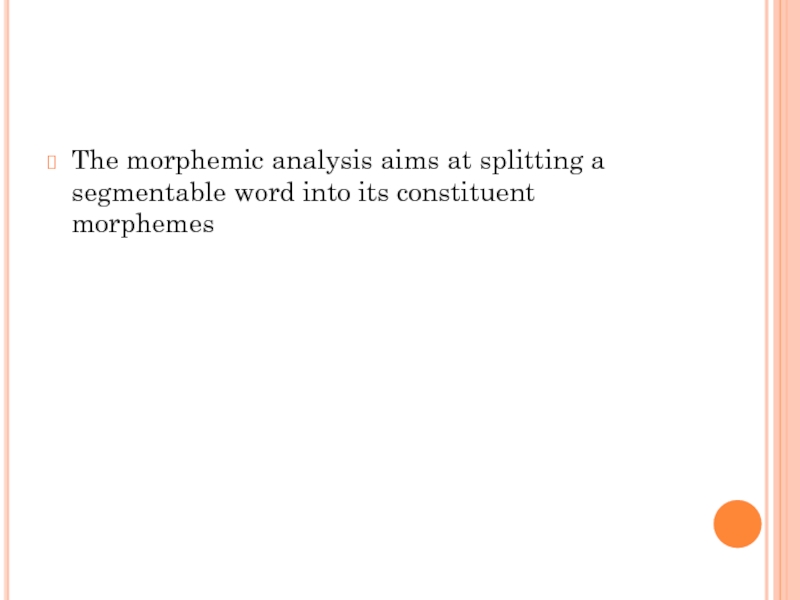
Слайд 3The operation of breaking a segmentable word into the constituent
morphemes is referred to in present-day linguistic literature as the
analysis of word-structure on the morphemic level
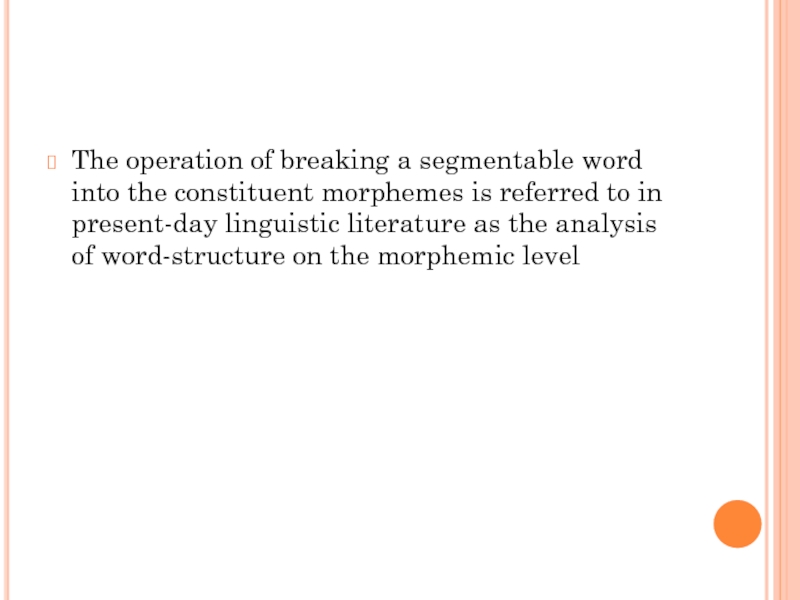
Слайд 4Three types of morphemic segmentability of words are distinguished: complete,
conditional and defective
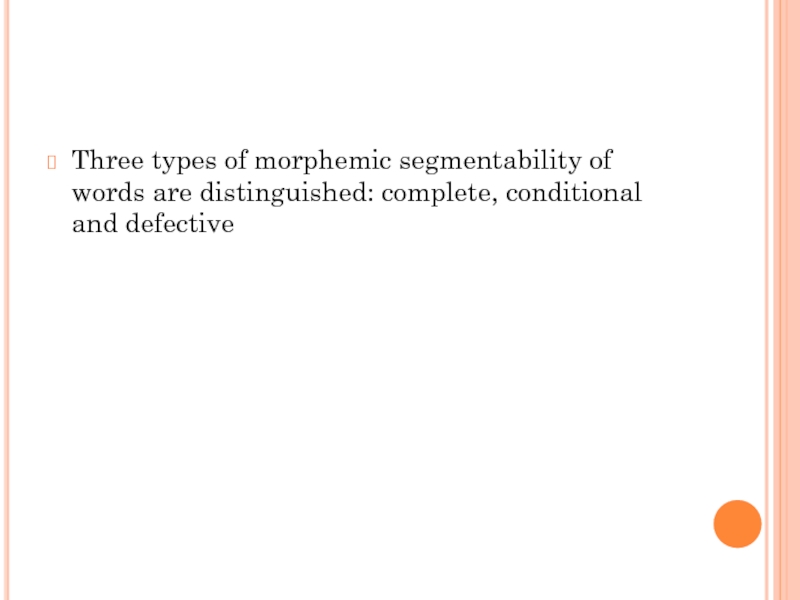
Слайд 5Complete segmentability is characteristic of a great many words the
morphemic structure of which is transparent enough, as their individual
morphemes clearly stand out within the word lending themselves easily to isolation
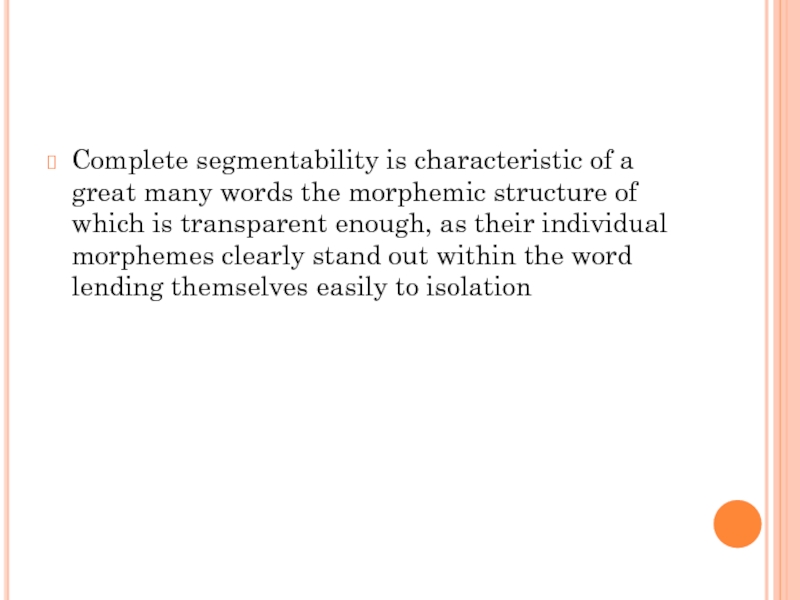
Слайд 6Conditional morphemic segmentability characterises words whose segmentation into the constituent
morphemes is doubtful for semantic reasons
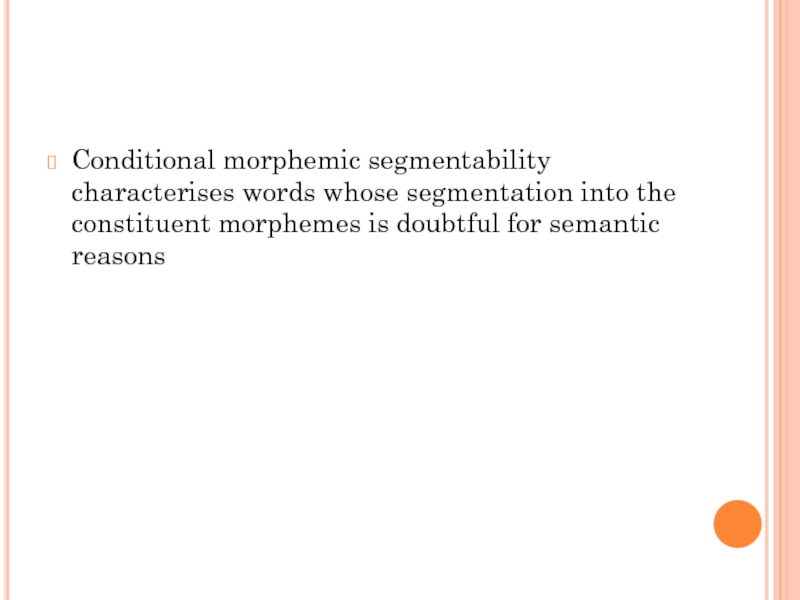
Слайд 7Defective morphemic segmentability is the property of words whose component
morphemes seldom or never recur in other words
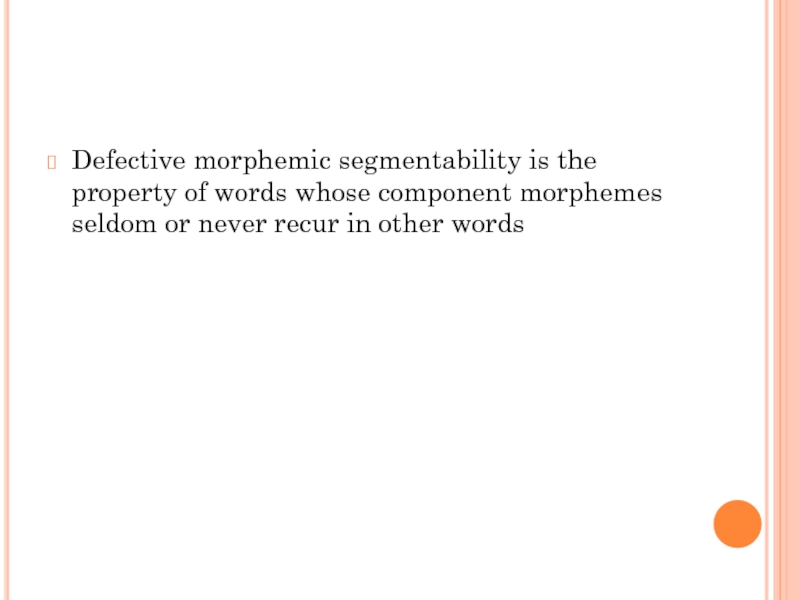
Слайд 8Semantically morphemes fall into two classes: root-morphemes(the root-morpheme is the
lexical nucleus of a ward, it has an individual lexical
meaning shared by no other morpheme of the language) and non-root or affixational morphemes
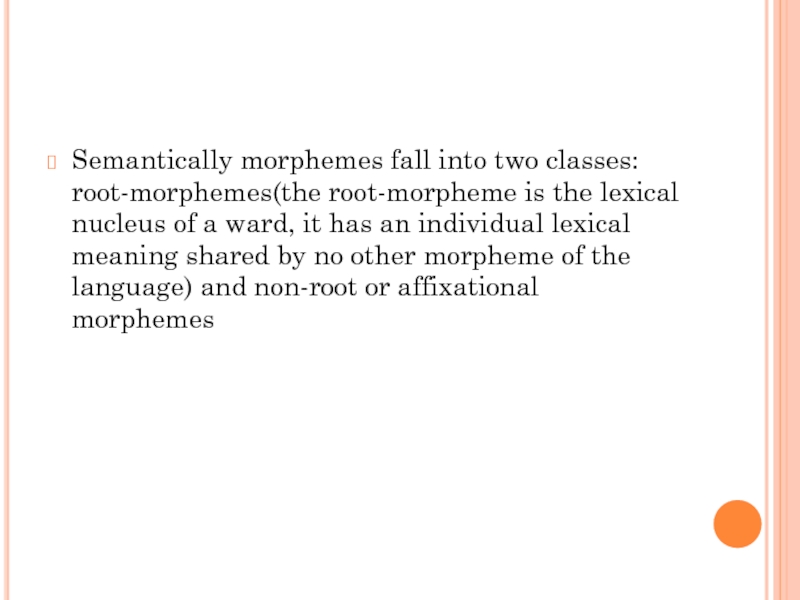
Слайд 9Structurally morphemes fall into three types: free morphemes, bound morphemes,
semi-free (semi- bound) morphemes
